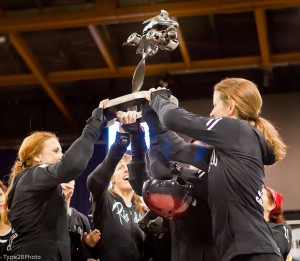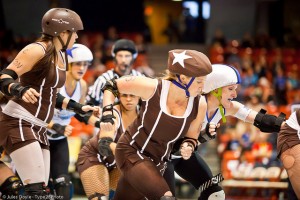Preface

RMRG's win(s) over reigning champion Oly Rollers were among the few high points of the 2010 Big 5 tournament.
Back in September I committed to offering alternatives to the WFTDA’s Big 5 tournament structure. Since this seems to be Fix It month at RDIT and I’m a fan of offering solutions with complaints, it’s high time to make good on that commitment. This post begins my series titled Fixing the Big 5, a look at alternative methods for executing the WFTDA’s annual championship series to suit the sport, the international organization, and those who take part in it (not just you, skaters, those people who buy tickets too).
At this rate the series may span a few months, but hold on to your hats ‘cause I’ve spent more than a couple months dwelling on this and I may just overload your brains with ways we could better showcase modern flat track derby and her top notch competitors. Today I’m starting with a look at the current Big 5 execution, how it came to be, and what it has going for it. In future posts I’ll be exploring options including Skill-Based Divisions, Knockout Tournaments (such as the NCAA’s March Madness), Wildcards, the English Football Pyramid (soccer to us in the U.S.A.), and maybe even Swiss Style if I’m feeling really exotic.
My goal is not to introduce you to the types of tournaments held in the sporting world- that’s what Wikipedia is for. My goal is to provide an analytical look at how WFTDA might apply another tournament structure to their series to improve the experience. We’ll take a look at what our past seasons’ tournaments may have been under another format and you’ll get an idea of where your team might fit into the mix.
If you’re curious about the Big 5, how it works, how it came to be, any why I’m dogging on it- check out my explanation. I wrote it up just for you but chose to remove it to appeal to the attention deficient and appease the TLDNR crowd. Click to read Speed Bump’s History of the Big 5 Tournament Series.
And with that, let’s get fixing:
Option 1 – Leave it Alone
For all the complaining I do about the Big 5- blow out games, uneven match ups, only 3 get to advance per region- I have to concede that the current setup does get some things right. I’ve been surprised by some of the defense received by and proponents of the current Big 5 system in discussing the tournament series. It was that silly robot, though, who really got me thinking on the live-and-let-live level.
Life Ain’t Perfect, Nor Shall We Be
The first owners of the hydra* didn’t even return to the championship tournament until this year. It goes to show how quickly and drastically an amateur team’s competitive level can change. The West Coast isn’t better than the East Coast isn’t better than the North Central isn’t better than the South Central, but the faces on those benches change constantly and with them the game that bench plays. Non-contracted players are free to move about, change their job, get knocked up, and go to jail. Whole teams can fold, divide, or suffer an identity crisis. Sometimes the track agrees with you and sometimes it doesn’t.

2009's #3 in the West and Championship contender couldn't even get out of their region this year, dropping significantly in their rankings.
My cause-effect rambling has a point and it’s this- it’s impossible to predict how well an amateur team will perform for a 6 month period let alone an entire season (~12 months). Bay Area started 2010 at the bottom of the Wild West barrel but regained their composure and came back to place 3rd in the regional tournament. Meanwhile Denver went from 3rd place in the Nation for 2009 to obscurity somewhere near the bottom of their regional bracket in 2010. Few of us saw either of these shifts coming and it’s hard to say what happened to the teams over the year to cause such swings. As the sport matures we’re seeing more consistency from many teams- the loss of one all-star skater isn’t the end of a truly developed team, the program can go on with the experienced players they’ve developed. But we’re still far from stable.
The regional tournaments stand as an excellent qualifying round to show where all teams stack up without flying them across the country to find out. By mid-season it’s pretty easy to establish which are your top 10 teams in the region and send invites. And yes, you’ll be surprised at how wrong you were on a few of those invites. But the cream will separate and your top teams for the region will go on.
The same will happen at the championship level and ultimately the best team for that year, with those skaters, under those real life conditions will be determined. Then those champions will retire on top, get knocked up, go to jail, and generally stop trying so hard because derby doesn’t pay and earning that Hydra was expensive.
By the Skaters for ALL the Skaters
WFTDA- having grown from a grass roots effort- retains its community aspects on several levels, but the equal representation of all regions at Championships underscores the point that all are important members of the derby community.
In a perfectly competitive world where even match ups are all that matters, Rocky Mountain would never have appeared in the same level of tournament as Nashville. The skill divide at 2010 Championships between the top teams of the East and West versus the bottom from the North and South was abysmal. We’re talking the Florida Gators vs. your local community college football club.
But regardless of skill divide, those lesser teams announced to the WFTDA’s world membership that they’d proven themselves in regular season play and bested their regional competitors to earn a spot at the big show. That’s a huge marketing and outreach opportunity for any derby league. You may lose in the first round by several hundred points, but your team name and your jersey colors have a place on the world map just for showing up.
Each of WFTDA’s regions gets this opportunity to show that derby exists and thrives in their neck of the woods. That’s huge growth potential for the club as new fans around the world learn that derby isn’t too far away- it’s attainable at the local level. And sometimes even little cities and new derby leagues have a shot at the veteran champions.
Upsets and Underdogs
The current Big 5 allows the greatest opportunity for new teams to quickly rise the ranks to Championship level. It gets back to the unpredictability of an amateur sport, but it’s an important feature unto itself- the wildcard nature of the Big 5.

Jet City made an impressive showing at Western Regionals in their first year even against long-time WFTDA member leagues.
Division based systems can be a glass ceiling for an up-and-coming league. If your winning streak starts too late or you don’t have opportunities to play enough higher-ranking competitors, it’s hard to rise to the next division. As we’ve seen in the short history of the WFTDA (remember: it’s an infant), teams develop seemingly out of nowhere to become champions in just one season (I’m looking at you, Oly).
As derby becomes more established and spontaneous growth subsides into long-term/sustained development, we’ll get fewer surprises coming from left field. In the mean time, though, it’s important to allow a fresh new team the opportunity to reach for the stars right away rather than pigeonholing them at the bottom of the Division III, Class D ranks until they can slowly prove themselves over the course of months.
Sure there will always be upsets and surprises- it’s a sport, after all- but the current Big 5 allows the best opportunity for a Cinderella story and has allowed the best teams to get where they need to be (which is the next part, cue segue…)
May the Best Women Win
 Ultimately it gets the job done. The Big 5 does determine an undisputed season champion by giving every team in every division an opportunity at the top slot. So it may be hazy (read: extremely suspect) for everything after 1st place, but you can’t argue that the top spot will go to the best team in the WFTDA at that time for that year. They squarely bested their own region and worked through the the Championship bracket including representatives of all other regions to come out on top.
Ultimately it gets the job done. The Big 5 does determine an undisputed season champion by giving every team in every division an opportunity at the top slot. So it may be hazy (read: extremely suspect) for everything after 1st place, but you can’t argue that the top spot will go to the best team in the WFTDA at that time for that year. They squarely bested their own region and worked through the the Championship bracket including representatives of all other regions to come out on top.
Option 1 in Summation – Sleeping Dogs Lie
Why I Like It (and you should too)
It’s the simplest option out there to make a fairly accessible, easy to manage tournament that represents WFTDA as a whole. You get to see and learn about teams you might not have known from cities you don’t care about. Teams get to skate against teams they might otherwise never play. Fans get to see talent from all over. Regional fans get to root for their teams and against the Big Bad West. Some dudes in Nashville get to dream big and make ridiculous videos only to lose their shirts in the first round (thank goodness they wore coveralls).
Why I Don’t Like It
Championships don’t showcase the best of the best. The current Big 5 is a poor representation of what the sport and its players have worked so hard to develop.
Championships don’t showcase the best of the best. The current Big 5 is a poor representation of what the sport and its players have worked so hard to develop. Blow outs and unbalanced match ups aren’t fun for the fans and don’t do the skaters any good. DNN’s Power Rankings tell a completely different story of what teams could adequately represent the athletic skill of the WFTDA, but one quarter of their top 12 couldn’t find space in the 3-team-per-region seating arrangement on the bus to Championships. Other ranking systems tend to agree that better representing, more competitive derby could have been experienced. On my scale of quality- where featuring the sport at its best and making a compelling sport are key- this options ranks low and doesn’t provide the derby community and potential fans what they need to keep the Big 5 viable.
**While TXRG is listed as the first WFTDA Champs, Caesar and I both recall the Hydra didn’t exist until the 2007 Championship (first “Nationals”). Please correct us if we’re wrong! [Update] See Andrew’s comment below.
*
Photos by Sharkey and Axle Adams.

